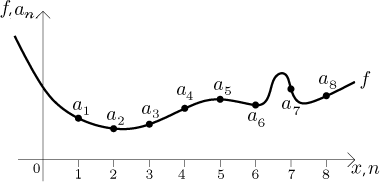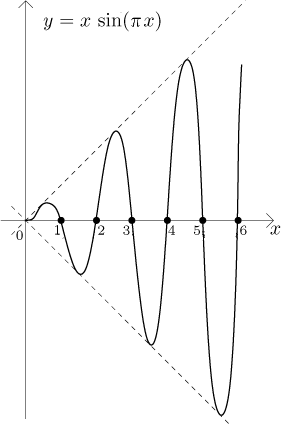
When a sequence is given by a formula (explicit definition), the same formula
usually also defines a function. Indeed, there are few formulas that would
work for positive integers but not for real numbers between them. One such
candidate is the factorial
So here is the typical situation. We have a function

What is the connection between properties of the function and properties of the sequence?
Since the sequence is just a part of the function, it inherits the relevant properties:
Theorem.
Letf (x) be a function defined on some(K,∞), define a sequence byan = f (n) for integersn > K.
• If f is bounded in any sense, then also the sequence{an} is bounded in the same sense.
• If f is monotone, then also the sequence{an} is monotone (in the same direction).
• If f has a limit L as x tends to infinity, then also the sequence{an} has limit L.
Therefore, when investigating such a sequence, we can try to investigate the relevant function instead, using powerful tools that we have for functions, and if we get some "positive" result, it will also be true for the given sequence.
Note that this procedure only works for "positive" properties.
If we learn that the function is not bounded, not monotone, or does not have
a limit ("negative" facts), then we cannot carry this over to the
sequence. Equivalently put, the implications in the theorem are not
generally valid in the other direction. It
may happen that the sequence
As an example, consider the function

We see that the sequence actually goes
What does it means for our investigation of sequences? When (if) we try to investigate the relevant function instead, and get some "positive" result, it also applies to the given sequence by the above theorem. On the other hand, "negative" results (the function does not have a limit at infinity, is not increasing, etc) do not automatically apply to the given sequence. In such a situation we have to use other tools to investigate the sequence, the function approach did not help.
Example:
We will show that the sequence
Solution: We will investigate the relevant function